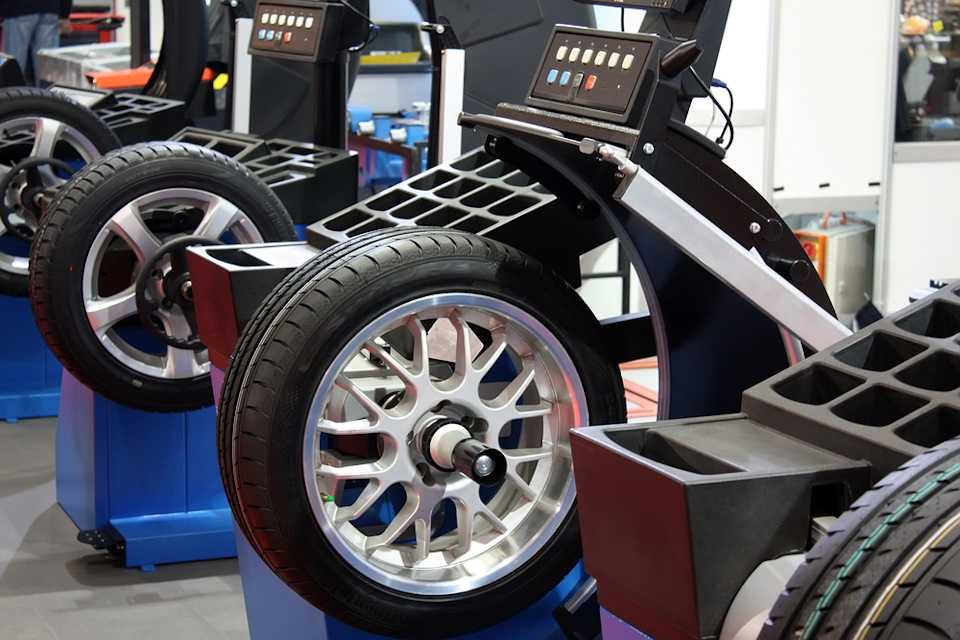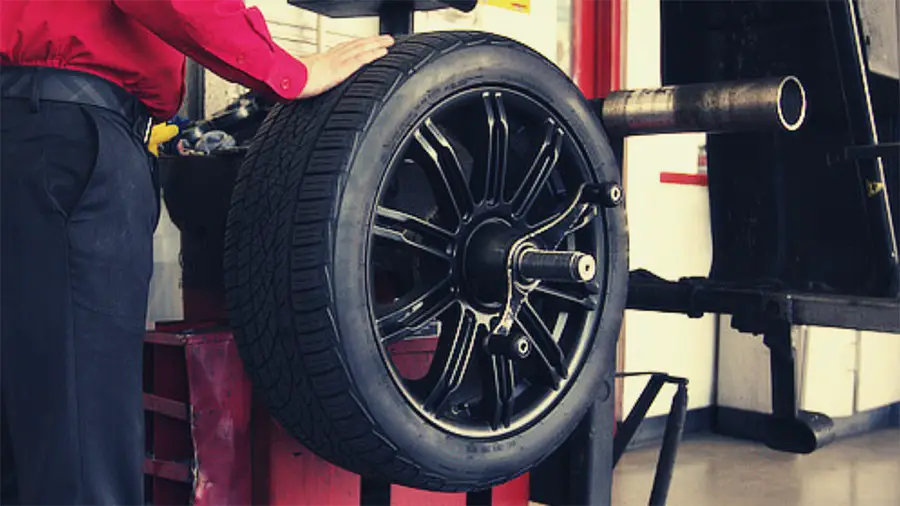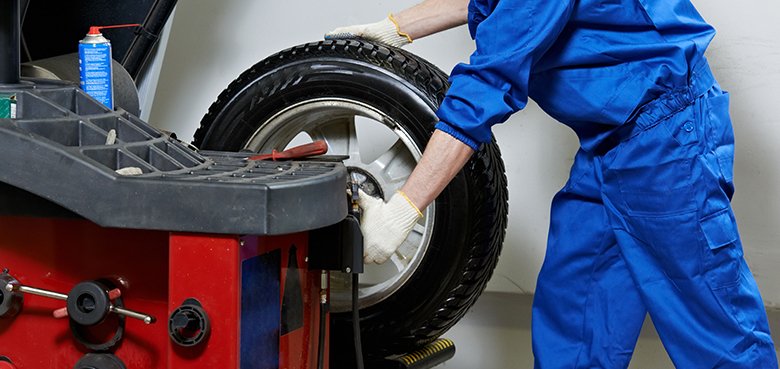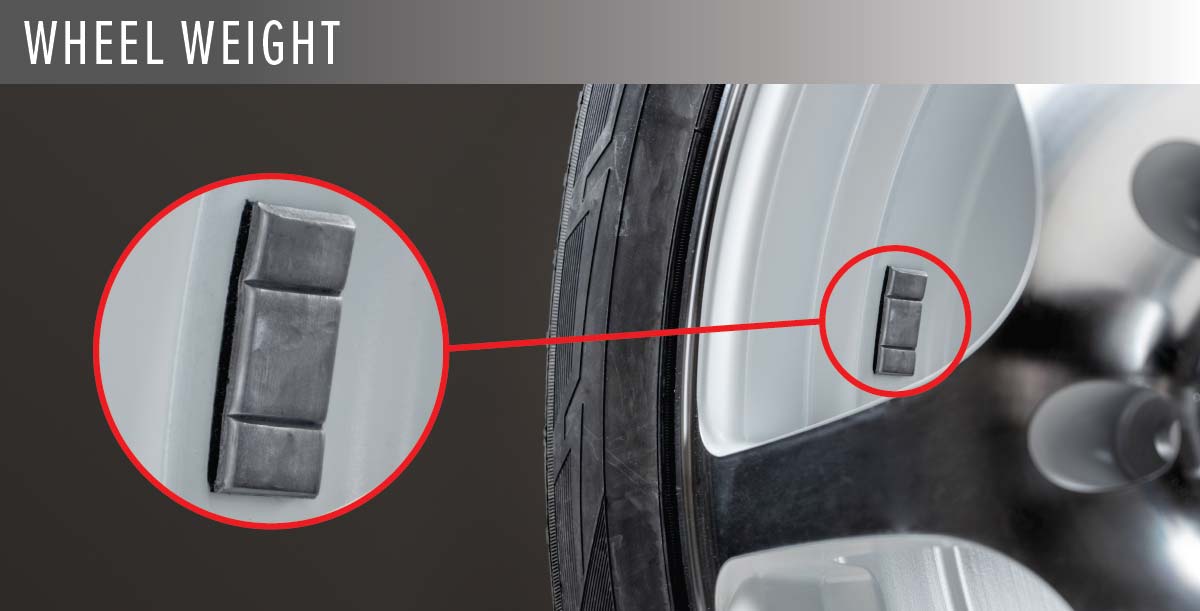Are you noticing a vibration while driving? Talk to an automotive mechanic to weed out causing-shaking possibilities i.e. wheel alignment, engine or transmission problems, driveshaft and axle failures, suspension wear or too much road force weight on one or more tires can be the culprit of vehicle vibration. Road force balancers, in addition to traditional balancing tires, is to measure both the tire and wheel by pressing a big roller against the spinning tire’s tread. The roller applies 1,200-1,400pound (0.64 ton) pressure to simulate the vehicle’s weight on the tire as it rolls down the road.
Along with several sensors, it is a computer in the machine that determines variations of radial runout, tire stiffness, and anything in the tire’s assemblage (like inconsistencies in the belt package) that’s preventing the tires from rolling smoothly when weighted by the car.
By measuring both tires and wheel, the road force balancer tells the mechanic where to move the tire around on the wheel until the tire’s effective high spot (when rolling on the car) matches the wheel’s low spot – a more sophisticated technique of match-mounting.
Road force balancing tires is actually more complicated than that, but that’s the simplest explanation on how the machine functions. In extreme cases (and when necessary) a road force balancer can be used to run several tires across various wheels to discover the best possible wheel-tire combinations.
Performing this technique prior to installing any set of wheels and tires, provides car owners with the same level of ride-comfort previously available only to OEMs. Plus, as an extra benefit to tire dealers, many road force balancers can optimize the corrective balance-weights (also, called match mounting), which results in considerable savings (on average 30%) in the amount of weight used. It’s in the best interest of the car owner to consult with a tire and wheel professional when shopping for tires by vehicle or by size. Shopping correctly and installing a new set properly, can improve previous ride quality. Is your vehicle riding with a mix of tires? See what professionals have to say on mix tires.
===============================================================
FAQS
Is Road Force Balancing Worth It?Yes for many, but this isn’t for every car owner. While an overkill for most customers, match mounting or road force balancing tires is useful for extremely low-profile tires as well as in solving persistent vibration problems. For car owners who want optimum quality, it’s a maintenance service that cannot be overlooked. But for customers who are yet undecided on whether to spend the money, you can look around for discount tire road force balance costs and compare other shops.
How Much Does It Cost to Force Road Balance Tires?
Balancing wheels requires dismounting tires and spinning them, and it generally takes less than 30 minutes. More often than not, pricing may be regional, but average cost is $25 per tire.
What Do Road Force Balance Numbers Mean?20+ pounds of road force is a lot and can be felt by a sensitive driver. In essence, road force places a number on how egg-shaped the wheel-tire assembly is (or how out-of-round it is). Each car varies on how much road force variation tolerance it has: some vehicles can handle significantly more, while some can only handle road force variations that’s less than 20 lbs. Diagnosing vibration issues, and having the lowest amount of road force on each tire will generally give you better ride quality.
What Causes Tires to Vibrate?
If at 40 mph (64.37 km/h) speed (or more), and your steering wheel vibrates, this means your wheel, tire, or possibly brake assembly is out of balance. This vibration is typically felt when sitting in the driver or passenger seat, or through the brake pedal. Vibration at higher speeds can also be caused by uneven tread-wear. Static imbalance makes a tire/wheel assembly vibrate up and down. Dynamic imbalance causes the assembly to shimmy from side to side. Other tire issues that can cause shaking i.e. low tire pressure, uneven worn, and near bald tires.
This vibration is typically felt when sitting in the driver or passenger seat, or through the brake pedal. Vibration at higher speeds can also be caused by uneven tread-wear. Static imbalance makes a tire/wheel assembly vibrate up and down. Dynamic imbalance causes the assembly to shimmy from side to side. Other tire issues that can cause shaking i.e. low tire pressure, uneven worn, and near bald tires.
Can road force balancing really make a difference?
To answer the question of whether road force balancing is overkill, we should probably start by reviewing some basics. We balance tire/wheel assemblies primarily to eliminate, as much as possible, vibration. Vibration produces ride disturbances that are uncomfortable for the driver and passengers and may cause uneven tire wear.
Some vehicle vibrations are the result of normal operation; even the best engines, transmissions and drivelines naturally produce some vibration. Others are due to some type of abnormal condition such as engine or transmission problems, driveshaft and axle failures, suspension wear or failure, improper wheel alignment, brake wear or failure, wheel bearing wear, tire/wheel assembly imbalance, out-of-round tire or wheel, or the force variation of a tire.
Others are due to some type of abnormal condition such as engine or transmission problems, driveshaft and axle failures, suspension wear or failure, improper wheel alignment, brake wear or failure, wheel bearing wear, tire/wheel assembly imbalance, out-of-round tire or wheel, or the force variation of a tire.
That’s quite a list, but everything beyond the last three items is beyond the scope of our discussion, so let’s assume that we have eliminated all of the non-tire and wheel related issues.
All tires have some amount of static and dynamic imbalance. Whether it causes any problems is a function of the amount of imbalance, the wheel and tire combinations, and how the tire/wheel assemblies interact with the vehicle.
Static imbalance makes a tire/wheel assembly vibrate up and down. Dynamic imbalance causes the assembly to shimmy from side to side.
Since the introduction of the modern spin balancer, most tire/wheel assembly balancing equipment has been able to accurately diagnose and correct both dynamic and static imbalance. However, balancers can only fix balance problems. Even the most sophisticated balancers cannot eliminate vibrations from a bent wheel or an out-of-round or irregularly worn tire.
However, balancers can only fix balance problems. Even the most sophisticated balancers cannot eliminate vibrations from a bent wheel or an out-of-round or irregularly worn tire.
Adding balancing weights can only correct weight differences; it will not compensate for other problems. In fact, in attempting to come up with a balance solution, balancer electronics all start out with the assumption that a tire/wheel assembly is within a certain maximum deviation from round. If an assembly is too far out, the balancer will probably not even be able to make a proper weight correction.
In addition to whatever imbalance it may have, because of the construction of a pneumatic tire, all tires have some variation in sidewall stiffness. It may be best explained by thinking of tires as if they were built with a series of springs in the sidewalls. Some of these imaginary springs are stiffer than the others.
When one of the stiffer springs (the stiffer part of the sidewall) is in position between the wheel and the road, the wheel is pushed up away from the road with more force than when a weaker spring (the softer portion of the sidewall) is between the road and the wheel.
This creates a vibration, undetectable with a normal spin balancer, as the car moves along the road. Whether the variation is noticeable (and by how much) varies with the particular vehicle and its tire and wheel assemblies.
The number of stiff points in a tire/wheel assembly is called the harmonic order; and there may well be more than one. A tire/wheel assembly with one stiff point has a radial first harmonic or R1H. If there were two stiff points, it would be R2H. Three stiff points and its R3H, and so on.
Both the stiffness of a tire’s sidewall and the lateral (side to side) and radial (variation from true round) runout of the wheel combine to determine the harmonic order. While repositioning the tire on the wheel can minimize first harmonics, second and third harmonics are more difficult to correct without wheel or tire replacement.
The radial force produced by variations in sidewall stiffness is called ‘road force variation’ and it cannot be corrected by balancing. Unfortunately, many tires have serious variations in road force that are visually undetectable.
Unfortunately, many tires have serious variations in road force that are visually undetectable.
All tire manufacturers test tires at their manufacturing facilities for uniformity, including road force variation, conicity (the tendency to roll like a cone), ply-steer (the tendency to crab sidewise) and balance. Acceptable levels of uniformity vary among manufacturers, tire lines and the planned distribution channel for the tire.
Not surprisingly, the most uniform tires typically go to the automakers for OE fitment. How much variation is acceptable for independent tire dealers versus the discount clubs is probably something that is not discussed in public.
As part of their uniformity measurements and to help with balancing, manufacturers usually place red or yellow marks (or both) on the sidewalls of their tires. The red mark indicates the point of maximum radial force variation (the stiffest point and effective “high spot”) and should be aligned with the wheel’s point of minimum radial runout (the wheel’s “low spot”), which is generally indicated by a colored dot or a notch somewhere on the wheel.
If the point of minimum radial runout is not indicated on a wheel, the weight method of match mounting should be used instead. When performing weight match mounting, the yellow mark on the tire, indicating the point of lightest weight, should be aligned with the valve stem on the wheel, which represents the heaviest weight point of the wheel. It is the heaviest point because the valve stem assembly, especially with today’s TPMS sensors, is heavier than the weight removed by drilling the hole for the valve stem.
Car manufacturers have been using road force wheel balancers for decades because even the best tires are not perfect. It’s done at the factory on every tire/wheel assembly to create that ever so important new car ride.
So what does a road force balancer actually do? Road force balancers, in addition to performing a traditional spin balance, measure both the wheel and tire by pressing a large roller against the tread of the spinning tire. The roller applies 1,200 to 1,400 pounds of pressure to simulate the weight of the vehicle on the tire as it rolls down the road.
The roller applies 1,200 to 1,400 pounds of pressure to simulate the weight of the vehicle on the tire as it rolls down the road.
A computer in the machine, along with various sensors, determines variations of tire stiffness, radial runout and anything in the tire’s construction (such as inconsistencies in the belt package) that would prevent the tire from rolling smoothly when it is weighted by the car. By measuring both the wheel and tire, the road force balancer tells the technician where to move the tire around on the wheel until the effective high spot of the tire (when it is rolling on the car) matches the low spot of the wheel – a more sophisticated method of match mounting.
It’s actually more complicated than that, but for practical purposes, that is what a road force balancer does. If necessary, in extreme cases, the road force balancer can be used to run several tires across different wheels to find the best possible wheel and tire combinations.
Use of a road force balancer can provide consumers with the same level of ride comfort previously only available to OEMs. An additional benefit to the tire dealer is that many road force balancers are able to optimize the corrective balance weights, resulting in considerable (upwards of 30%) savings in the amount of weight used.
An additional benefit to the tire dealer is that many road force balancers are able to optimize the corrective balance weights, resulting in considerable (upwards of 30%) savings in the amount of weight used.
So when is road force variation balancing useful and when is it overkill? It has become more useful as aspect ratios have gotten lower.
We have changed from a market dominated by tall tires where the distance from the wheel to the tread was fairly large and relatively flexible. Today, most tires have a much lower profile. The sidewall is stiffer and the distance from the rim to the top of the tread is shorter, often much shorter. This means that minor imperfections will be amplified and more vibration transmitted into the car.
It can be argued that all drivers can benefit from road force balancing because it is always helpful to “test drive” the tires before the vehicle gets on the road. Road force balancing enables the technician to resolve potential vibrations proactively. Realistically not every customer is going to want to pay extra for it, but it is especially beneficial for drivers of high-performance vehicles with low-profile tires (45-series and lower).
Realistically not every customer is going to want to pay extra for it, but it is especially beneficial for drivers of high-performance vehicles with low-profile tires (45-series and lower).
It can also be a great option when a customer complains about experiencing an annoying vibration at highway speeds or a continuous shimmy in their steering wheel – especially after multiple attempts to correct the problem by tire/wheel rebalancing.
Bottom line, road force balancing is likely not for every customer. While it is overkill for many customers, it is also a very useful tool for extreme low profile tires or to resolve persistent vibration problems. For customers who want the “best,” it is a legitimate premium service, and you should charge as such.
In this article:
Keeping the wheels on your vehicle in balance is essential to the performance of your tires and your vehicle as a whole. In addition to providing a smooth ride, the 's balancer is a key component in tire wear. This article will help you understand how the balances the and why it is important to keep your tires balanced throughout their life.
This article will help you understand how the balances the and why it is important to keep your tires balanced throughout their life.
If you think that wheel balancing is not that important, then let's look at some aspects that can help you rethink this issue. Perhaps the most compelling argument for fine balancing is the fact that vehicles are getting lighter and lighter. Previously, cars were heavier and this helped to smooth out vibrations while driving to the point that the driver simply did not feel them. Soft pendants give the same effect. However, for our roads, you often have to choose SUVs, which usually have stiffer suspensions. Another argument in favor of timely tire balancing is the trends in tire technology itself. As a general rule, lower profile tires (low profile tyres) provide better feedback and handling on the road. As a result, the slightest imbalance (at least 10 grams) can be felt in most modern cars. This is significantly less than the average ten years ago. For those who have large tires on the car, balancing is even more critical.
For those who have large tires on the car, balancing is even more critical.
Before discussing balancing technology, let's look at why imbalance occurs. When the tire is put on the disk, an assembly weighing approximately 15-18 kg is obtained (this is the average weight of a modern wheel). The probability that in this case the wheel will be balanced both radially and in the lateral plane is practically zero. And the slightest imbalance (even 10 grams) can cause the driver to feel vibration.
The figures below show how imbalance creates vibration.
| Static imbalance: Occurs when there are heavier or lighter sections in the tire. This imbalance leads to vibrations up and down. |
| Dynamic unbalance: Appears when the weight is unevenly distributed on the sides of the wheel. This causes the wheel to wobble from side to side. |
Most assembled wheels have both types of imbalance and require dynamic balancing. You probably saw more than once when you came to tire fitting how a specialist puts the assembled wheel on a special pin of a balancing machine and the system tells him how to place counterweights. This is done in order to evenly distribute the weight and compensate for the imbalance. After proper balancing, the weight is distributed evenly and the wheel will not vibrate. Your tires will roll smoothly on the road and wear evenly. Thus, not only the tires will last longer, but also other parts of the car, since they will not be affected by additional vibration.
You probably saw more than once when you came to tire fitting how a specialist puts the assembled wheel on a special pin of a balancing machine and the system tells him how to place counterweights. This is done in order to evenly distribute the weight and compensate for the imbalance. After proper balancing, the weight is distributed evenly and the wheel will not vibrate. Your tires will roll smoothly on the road and wear evenly. Thus, not only the tires will last longer, but also other parts of the car, since they will not be affected by additional vibration.
Keep your wheels in balance!
For the sake of this example, let's say you have traveled 8,000-10,000 km since you bought your new tyres. This means it's time for tire rotation and balancing. During this time, you have made thousands of turns, sharp braking and acceleration. And on our roads you still flew into pits, ran into bumps, ran over speed bumps and tram rails. All this leads to uneven wear of the tread on the tires. Uneven tread wear creates an imbalance. Even if you don't feel the vibration, it's still about every 10,000 km of run balancing is usually broken. Considering how much vibration repairs can cost and how much new tires cost, swapping and balancing tires to make them last longer is smart.
Uneven tread wear creates an imbalance. Even if you don't feel the vibration, it's still about every 10,000 km of run balancing is usually broken. Considering how much vibration repairs can cost and how much new tires cost, swapping and balancing tires to make them last longer is smart.
It happens that the wheels are balanced, but the vibration is still felt. What could be the reason?
Regular balancing at our tire shop will allow you to detect and eliminate the causes of vibration in time.
Depending on the type of wheel, the position of the weights during balancing may differ.
| Normally the weights are attached as shown.  This is how they are installed on most steel and some alloy wheels. This is how they are installed on most steel and some alloy wheels. |
| Sometimes a combined method is used. Conventional weights are installed on the rim and special adhesive counterweights are installed on the inside (weights for balancing on a sticky basis). |
| Some wheels are designed so that only adhesive weights can be used for balancing. This applies to chrome rims and wheels with a delicate finish. |
Come visit us for tire service ! Our address: St. Petersburg, per. Decembrists, d.20. Trust your car to professionals. Balancing is not as expensive as suspension repairs and new tires.
Prices for balancing are given in the price list for tire fitting .
The text of the article is largely translated from English and the pictures are here: www.discounttire.com/dtcs/infoTireBalancing.dos Tire Balancing - Discount Tire new tire prices: Most motorists are wondering if wheel balancing is necessary immediately after installing new tires, or is this procedure necessary after each re-beading? Is it possible to balance only the front wheels and leave the rears as they are? Balancing is related to the ease of movement on the vehicle - unbalanced wheels cause vibration, which is not very pleasant for the driver, and wear of tires, wheels and suspension is also accelerated. The main thing in balancing is the even distribution of the weight of the wheel relative to its center. After balancing, vibration becomes minimal, wear of discs and tires is prevented. Wheel balancing is the elimination of wheel imbalance when its mass is unevenly distributed across the width. The tire fitter puts weights on both sides of the rim in the right places. The work is carried out on a machine designed for balancing, it automatically finds places to install weights. Depending on the type of disc, the type of weights that will be used is determined - the weights can be made of lead, zinc and differ in weight - from 5 to 100 g. Stuffed wheels are generally used for balancing wheels with stamped rims. Adhesive used for wheels with forged or cast rims. They are placed from the edge of the disc, from the inside, near the spokes. Specialists find a stuffed load to be more convenient. Adhesive cargo is less resistant to sudden changes in temperature, as well as frost - the cargo loses its stickiness and may fall off. In addition, the load is likely to fall off when washing under the pressure of water. Balancing is required after the wheels have been fitted and also after a beading. Masters advise to do balancing systematically, since it can be disturbed due to: The rear wheels also need to be balanced. There are some features of wheel balancing: Balancing is required for ease of movement, keeping the wheels in working condition for a long time, and, in addition, for the correct operation of the suspension. You also need to remember that balancing is also required for the rear wheels of the car.
Prices for tire fitting Wheel alignment prices Prices for seasonal tire storage Prices for new tires Wheel balancing and why it is so important
How is balancing carried out and in what situations is this procedure necessary?
What does wheel balancing affect?
 Therefore, balancing also affects the correct operation of the suspension. When the wheels are not balanced, the machine loses stability when driving at high speeds, which is fraught with an accident on the roads.
Therefore, balancing also affects the correct operation of the suspension. When the wheels are not balanced, the machine loses stability when driving at high speeds, which is fraught with an accident on the roads. How is wheel balancing done?
 Weights are fixed on the outer and inner edge of the disk.
Weights are fixed on the outer and inner edge of the disk. When is balancing needed?
 Front wheel imbalance is usually more noticeable than rear wheel imbalance. It can be seen at speeds over 120 km / h - the car begins to vibrate. The unbalance of the rear wheels destroys tires, suspension, wheels.
Front wheel imbalance is usually more noticeable than rear wheel imbalance. It can be seen at speeds over 120 km / h - the car begins to vibrate. The unbalance of the rear wheels destroys tires, suspension, wheels. Wheel balancing
Basic balancing errors
